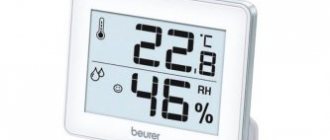Home / Encyclopedia / Harm of dry air to humans
Clinical trials have shown that a person feels comfortable at a relative humidity of 40 to 60% . What can a decrease in its level lead to?
Dry air, as is known, tries to “saturate” itself with water, which it begins to “suck” from its environment. These include indoor plants, an aquarium, wooden furniture, and, of course, the person himself.
What is air humidity
In molecular physics, air humidity refers to the content of water vapor molecules in the air around a person. One hundred percent humidity is characterized by the appearance of condensation on surfaces. There is precipitation outside at these levels.
Normal humidity in a living space is usually different from that outside. In an apartment it is more stable, while in the environment it changes under the influence of changing seasons - in autumn and spring it is higher, in winter when there is frost and in summer when it is very hot it is lower.
Fluctuations in humidity are caused by temperature. When it is too high, water molecules evaporate, and when it is very low, they crystallize. In a living room, air is most often made dry by central heating radiators.
What does deviation from the norm lead to?
If the average room humidity is significantly higher than normal (more than 20–30%), various problems may arise:
- The appearance of mold. A humid and warm environment is the optimal condition for the development of fungal spores. Mold most often forms in the bathroom, kitchen, and corners of rooms. In children and people with weakened immune systems, it can cause respiratory problems and allergic reactions. For asthmatics, damp rooms are dangerous because prolonged exposure to them provokes frequent attacks.
- Increased heat transfer. In hot summer weather, high temperatures are felt worse when there is an increased content of moisture particles in the air. The result may be overheating or heatstroke.
Dependence of the development of diseases and fungi on the humidity in the apartment
It is the state of health of the residents of the room that determines what humidity should be in the house. Too high is not suitable for asthmatics, allergy sufferers, small children, people with hypertension, cardiovascular diseases and immunodeficiency.
If the humidity level in a room for a person is not met and the air is too dry, this is also harmful to health:
- Dry mucous membranes. This can manifest as itching and irritation of the eyes, especially in people with contact lenses, a sore throat, and a hacking cough.
- Difficulty breathing. When the mucous membranes of the nasopharynx dry out, they do not perform their protective functions. A person becomes susceptible to colds and infections, nosebleeds, chronic rhinitis, and exacerbation of bronchial asthma.
- Deterioration of skin condition. Peeling, irritation, redness, the appearance of wrinkles - all this occurs against the background of a violation of the hydrobalance of the skin. High air humidity has a particularly bad effect on people with psoriasis, atopic dermatitis and other dermatological diseases.
Most unpleasant symptoms do not appear immediately. But if there is no normal humidity in the apartment, sooner or later its residents will begin to experience discomfort.
Problems arising from lack or excess moisture
Dry indoor air provokes increased moisture loss through the skin and respiratory tract. This can lead to such unpleasant consequences as:
- decreased elasticity of hair, nails and skin, accompanied by the appearance of microcracks, wrinkles, peeling, dermatitis;
- drying of the mucous membrane of the eyes, the symptoms of which are itching, redness, and a feeling of “sand”;
- thickening of the blood, leading to a slowdown in blood circulation, weakness, headaches, decreased performance, and increased stress on the heart;
- an increase in the viscosity of gastric and intestinal juices, causing a slowdown in digestion;
- drying out of the mucous membranes of the respiratory tract, which results in a weakening of local immunity and an increase in the frequency of acute respiratory viral infections;
- an increase in the amount of respiratory allergens in the atmosphere, which should normally be bound by liquid droplets.
Excess moisture in the air creates acceptable conditions for the growth of mold, fungi, and bacteria. As a result, you may encounter the following problems:
- 330
More details - 252
More details
- 192
More details
- 648
More details
- respiratory diseases - chronic runny nose, bronchitis, asthma, allergies; feeling of stuffiness or dampness in the room;
- unpleasant odor due to the proliferation of pathogenic microorganisms;
- increasing the drying time of washed laundry.
Excessive or insufficient amount of moisture in the house has a bad effect on the condition of home furnishings. Plants dry out or begin to rot, wooden furniture and parquet floors become deformed or “shrink,” paintings fade, paper products lose their structure.
The norm of air humidity in the apartment
Recommended GOST 30494-96 air humidity in the room depending on the time of year:
- in winter – 30–45%;
- in the autumn-spring period - 30–45%;
- in summer – 30–60%.
Optimal indoor humidity for people of different ages:
- for adults – from 40 to 60%;
- for children under 6 years old – 50–60%.
The ideal air humidity in an apartment for a person varies depending on the purpose of the room:
- in the bathroom, where the ceiling, walls and floor are usually resistant to water, humidity can reach 60–70%;
- normal humidity in rooms reserved for the kitchen, corridors, pantries is 40–60%;
- in rooms where there are plants, the humidity should not be lower than 60–70%, for tropical and subtropical flowers – up to 80–95%, so it is recommended to take them out onto the balcony, loggia or give them a separate room;
- It makes no sense to regulate humidity on a loggia or balcony, since this is a non-residential premises.
According to SanPiN 2.1.2.2645-10, the relative humidity for premises is placed within a more rigid framework and has values of 60% in the cold season, and 65% in the summer. Some rooms are not standardized due to non-constant or short stay in them, as well as frequent and long-term changes in humidity in these rooms
| The name of a room | Air temperature, °C | Relative humidity, % |
| winter | ||
| Living room | 18–24 | 60 |
| Room in the coldest five-day areas (minus 31 °C and below) | 20–24 | 60 |
| Kitchen | 18–26 | N/N* |
| Toilet | 18–26 | N/N |
| Bathroom, shared bathroom. node | 18–26 | N/N |
| Lobby | 14–20 | N/N |
| Storerooms | 12–22 | N/N |
| summer | ||
| Living room | 20–28 | 65 |
* - not standardized
To increase the service life of household appliances, the safety of books, paintings, and upholstery of upholstered furniture, the humidity level should not exceed 60–65%.
High humidity
Let's consider a situation where the humidity in the apartment is high.
- If the air is too humid, the body perceives temperature differently. The process of heat transfer is disrupted; at high temperatures the body overheats, at low temperatures it becomes hypothermic.
- This phenomenon, combined with high indoor temperatures, is especially dangerous for people suffering from hypertension and cardiovascular diseases: it leads to dehydration and chemical imbalance, blood thickening, high blood pressure and exacerbation of chronic heart and vascular diseases.
- High humidity negatively affects the physical and mental activity of even a completely healthy person, since fatigue sets in much faster in such conditions.
- If a person is in a room or apartment with high humidity, he is more susceptible to infectious diseases and colds. A long stay in such conditions can contribute to the development of more serious diseases: rheumatism, tuberculosis, etc.
- High moisture content in the air is dangerous for allergy sufferers. The environment in damp rooms is very favorable for the appearance of mold and fungi - powerful allergens that can lead to truly adverse consequences for the body, not to mention the fact that they spoil the appearance and decoration of the apartment.
In addition to fungus and mold, high humidity promotes the development of various pathogenic microorganisms and insects. It spoils furniture and creates an unpleasant musty smell.
Low humidity in an apartment has the following consequences:
- Too dry air dehydrates the body and dries out the mucous membranes. Dry nasal mucosa is the cause of frequent colds.
- The skin becomes dry, inelastic, and metabolism is disrupted.
- People experience constant nasal congestion and difficulty breathing, which lead to sleep disturbances, anxiety and irritability.
- Dry air in an apartment contributes to the spread of dust, in which various microorganisms, as well as dust mites, can multiply.
- The leaves of indoor plants dry out and fall off.
- Wooden furniture and parquet dry out and become cracked. The same applies to musical instruments made of wood: they are constantly out of tune and gradually become unusable.
USEFUL INFORMATION: Laminated drywall: pros and cons, application and installation options
Normal air humidity in a child's room
The optimal air humidity for a child in an apartment is determined based on his age. Compliance with this parameter is especially important for newborns:
- Features of thermoregulation in infants. The drier the air (which the child inhales), the more fluid the body will spend to hydrate it. This is associated with large losses of water - dryness of the mucous membrane of the nasopharynx and nasal cavity occurs, and it is difficult for the baby to breathe. As a result, he wakes up more often at night, eats poorly, and is capricious.
- Long heating season. In most Russian cities it lasts at least 6 months a year. Central heating radiators can reduce the initial humidity levels in a room by 20–40% or more. Low humidity during the heating season leads to frequent respiratory diseases, chronic rhinitis, and an increased risk of bronchial asthma.
Optimal humidity in a child's room is especially important.
Depending on the age of the child, it is determined what humidity should be in the bedroom. For children in the first year of life, the optimal parameter is 50–70%, for children from 1 to 3 years old – 45–65%, for children over 3 years old almost adult norms are suitable – 50–60%.
Bottom line
Appearance is also influenced by negative factors. According to the doctor, in a room with low humidity, the skin begins to dry, evaporating its own water.
“The skin becomes more sensitive and susceptible to allergens and opportunistic microorganisms that live on it. This fact is especially unfavorable for people suffering from atopic dermatitis, skin xerosis, psoriasis and other skin diseases,” says the doctor.
The dermatovenerologist emphasizes that aging processes are activated in heated rooms. Small wrinkles appear in the area around the eyes, and cracks form in the corners of the lips.
“Loss of moisture leads to impaired blood circulation in the upper layers of the skin. She receives less nutrients, which makes regeneration difficult,” explains Natalia Zhovtan.
The expert notes that low humidity is also harmful to hair. They become dry, thin and brittle. During the heating season, emollients come to the aid of the skin - products that moisturize the skin. According to the doctor, daily use of these products immediately after water procedures significantly reduces the feeling of tightness and relieves itching.
Photo: depositphotos/oksun70
How to measure humidity
Relative humidity in the room is measured using special devices - hygrometers. They have different designs and operating principles:
- Electronic. Usually combined with thermometers to simultaneously measure room temperature. In them, a thin layer of electrolyte is applied to the inner plate, through which voltage passes. The results are displayed on the indicator panel.
- Mechanical. Cheaper and easier-to-use instruments, however, can produce measurement errors of up to 8%. They operate without a power source and are available as tabletop or wall-mounted. They do not have a digital display, but are equipped with a dial and arrow.
Electronic hygrometers have good accuracy and are affordable.
There are many ways to determine the saturation of air with moisture, not all of them are popular, but there are:
- Weighted or absolute. It is a device that determines relative humidity by absorbing it. Using special tubes with a chemical composition, he takes measurements. Do not use in domestic conditions.
- Hair. This type of hygrometer is used only in laboratories, and only because its operating principle is based on the study of human hair.
- Film. Also belongs to the category of laboratory instruments. The main mechanism is a special film, which, depending on the level of humidity, stretches or, conversely, contracts. It is most effective to use it in the winter season.
- Electronic. This type of device is most often purchased for household humidity measurements. It is quite simple to use, since the mechanism immediately displays the final measurement result on the touch screen.
- Psychometric. The most accurate type of moisture meter. Often it is purchased for work in production and laboratory premises. Also, many “civilian” users choose psychometric hygrometers because of their comparatively low cost and extreme accuracy.
To determine the standard air humidity in an apartment, an inexpensive mechanical hygrometer is suitable. For domestic use, certification by the metrological service is not required.
It is important to pay attention to the temperature range of use - the maximum value is 80–120 degrees. When used in a sauna or bathhouse, you must choose the extreme option.
Determining humidity without instruments
You can independently find out quite accurately the air humidity in the room without having any instruments. There are two options for this.
When measuring using the first method, you need to measure the air temperature in the room with a thermometer and record the readings. Then take a small piece of cloth or bandage, wet it and wrap the tip of the thermometer and leave it for about 5 minutes. Next, having calculated the difference in readings (subtract the smaller from the larger), you need to use a psychrometric table.
Psychometric table for determining relative air humidity
In the second case, you need to pour a glass of water and cool it in the refrigerator to +3...+5°C. After this, move the glass to a room away from heating devices and leave for 10 minutes. We look at the glass if:
- The glass is dry. The humidity in the room is insufficient.
- There is condensation on the walls. The humidity is fine.
- Large condensation and drips. The humidity is too high.
Increased condensation on a glass with drips indicates increased humidity
Why is air humidification necessary?
People, materials and products require their own specific air humidity. If the relative humidity is too low, water from the surface layers will move into the air. As a result, people will have dry lips and skin, less resistance to various viruses, wood will dry out and crack, paper will become deformed. This list is quite long. It is important that users understand the effect that insufficient air humidification can have in a particular situation. Because often they don't realize it!
Relative humidity (RH%) is not usually measured. It is not related to specific problems experienced by the user. Letting the client know how much he will gain through proper air humidification is the first step for us in the communication process.
The second step is to show the client that since the humidification system provides important practical results, it is not worth buying the cheapest system. The customer should get a fair return on their money: low power consumption, reliability and high efficiency. Most inexpensive household systems are physically unable to cope with the task due to low performance, several times less than the calculated values.
The third step is to inform the client about the possible health risks that a poorly designed system poses (fungus, legionella and other microorganisms). Rotary mechanisms and ultrasonic systems that promote the rapid growth of microorganisms pose a serious risk to human health. This is the third argument why the buyer should pay attention to safe systems.
How to increase air humidity with household appliances
The most affordable and popular device for increasing humidity in the air is a household humidifier. It can be used all year round, but it will be especially useful in winter, when indoor humidity of 20 percent causes discomfort.
The following types of humidifiers are available:
- Classic. The operating principle of such devices is based on the evaporation of cold water without preheating. Water flows from a special container onto the evaporator - disk, filter or cartridge. Due to the fact that such devices take air from the room and release it after cleaning with a filter, additional removal of dust and allergens occurs.
- Humidifiers with air purification function. These are full-fledged climate control devices that simultaneously increase the level of humidity and purify the air by equipping them with special replaceable filters. They are also called air washers.
- Steam models. The operating principle of such devices is similar to the operation of an electric kettle. Heating elements with a ceramic plate or coil release steam after preheating the water. It is optimal to use both in summer and to maintain humidity levels in the apartment in winter.
- Ultrasonic. The most expensive and effective. The liquid poured into the reservoir flows onto a plate that vibrates under the influence of ultrasound. The water breaks up into tiny droplets, which enter the room through a cooler inside the case.
Air humidifier with cleaning function (air washing)
Steam humidifier
Ultrasonic humidifier
With the help of such devices you can not only create comfortable humidity in the apartment, but also regulate other parameters:
- control temperature;
- neutralize pathogenic microbes;
- trap dust and allergens.
The action of a humidifier can cover different areas, which must be taken into account when purchasing. Small household appliances are suitable for the bedroom or kitchen. For a living room or other larger rooms, you need a powerful device.
How to increase air humidity using folk remedies
Air humidity in a dry room can be increased using traditional methods:
- regular wet cleaning;
- frequent ventilation (not in sub-zero temperatures), especially after rain;
- installation of a mini fountain, aquarium or other water containers;
- growing flowers and watering them regularly;
- reducing the intensity of heating radiators using wet towels;
- using a spray bottle.
Folk remedies to increase the humidity in the room
To increase the humidity in the room, you can dry clothes directly indoors, and not on the balcony or street. When cooking food, water vapor from boiling pots also enters the air.
How to reduce humidity
High humidity is not always a good thing. If mold, mildew appears on the walls, or condensation constantly collects, it must be reduced. You can use one of these methods:
- Dehumidifiers. Special devices absorb excess water molecules, taking air from the room. The principle of operation of such a device is based on the condensation of steam in the room. The air conditioner performs part of the functions of a dehumidifier - it also takes water from the air.
- Good ventilation. Clogged air ducts do not cope with the function of removing excess wet air from the apartment.
- Drying clothes outside or on the balcony. When drying, the fabrics release water molecules into the air, which circulates throughout all rooms and increases humidity.
- Sunlight. When it enters a room, it causes water to evaporate, so it is recommended to open windows regularly.
Some factors that increase humidity cannot be influenced:
- the more people live in an apartment, the lower this figure will be;
- if all the windows face north, the rooms most often have dampness;
- In some cities, climatic conditions determine constant high humidity.










